This Pad Thai recipe is fast and easy to make with simple, authentic ingredients in under 30 minutes! Add shrimp, chicken, or tofu for a delicious vegetarian version. Video.
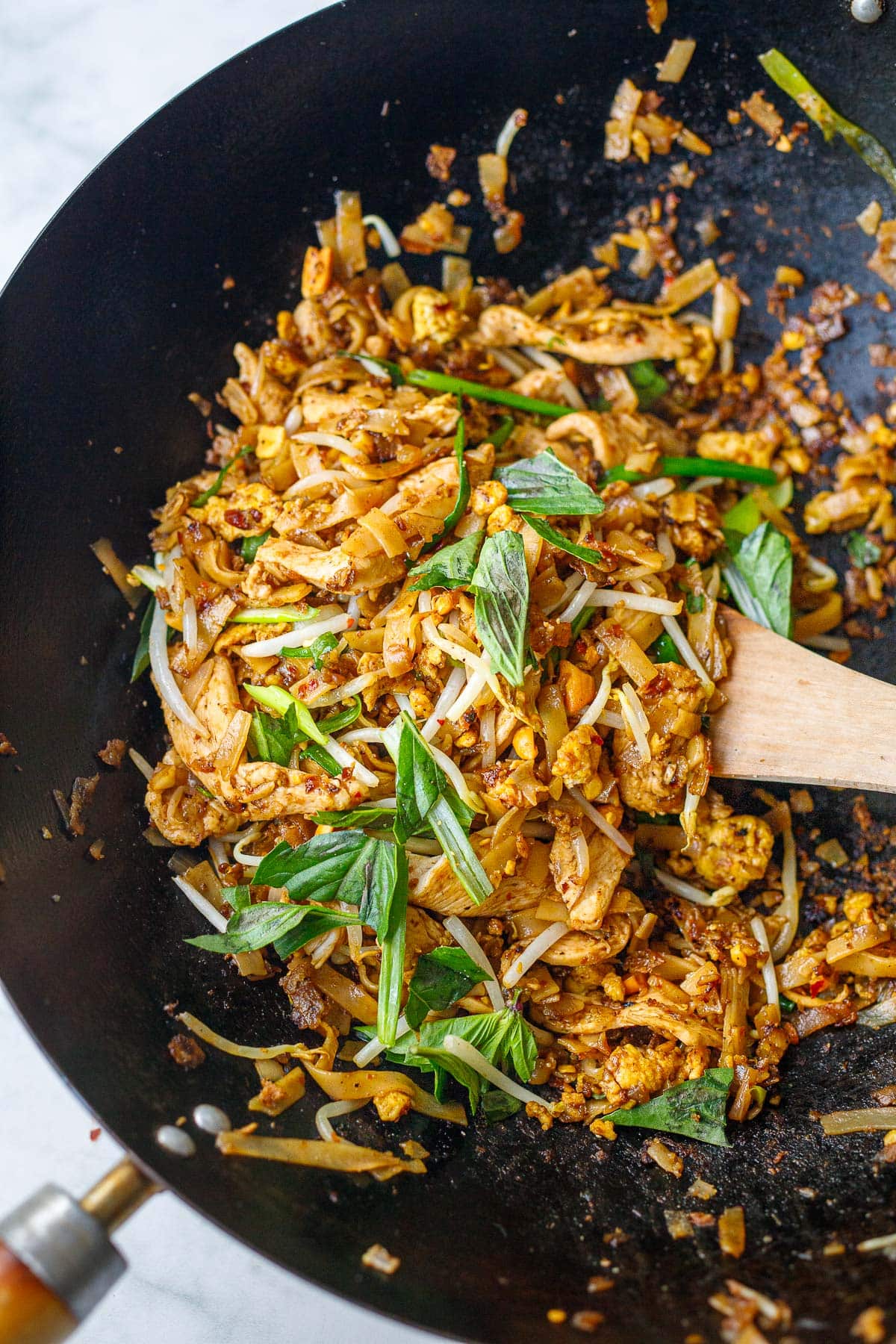
As a chef and caterer, I’ve cooked and eaten a lot of Pad Thai in my lifetime, both here and all throughout Thailand. We’ve captured the authentic flavor you’ll find in Bangkok while keeping the ingredients simple and the cooking fast and easy.
I may be biased, but I think this is the best Pad Thai recipe around—not overly sweet like many Americanized versions. You’ll find no ketchup or peanut butter in this recipe. But don’t take my word for it; just read all our great reviews!
But first, What is Pad Thai?
Pad Thai is a popular stir-fried noodle dish from Thailand made with rice noodles, shallot, garlic, scrambled eggs, and a protein, typically chicken or shrimp, in a flavorful, tangy, umami Pad Thai Sauce. It’s served with fresh bean sprouts, crushed peanuts, scallions and lime.
Why this Pad Thai Recipe is the Best!
- Balanced Flavor. Pad Thai sauce is a delicate balance between umami, sourness, and sweetness. Most American versions are way too sweet; this one is just right.
- It’s adaptable! This recipe can be made with chicken, shrimp, tofu and /or veggies! Gluten-free, vegetarian and vegan-adaptable.
- Quick and Easy– Once the ingredients are prepped, this takes 15 minutes of cooking time!
- Simple Ingredients. These accessible ingredients can be found in most grocery stores.
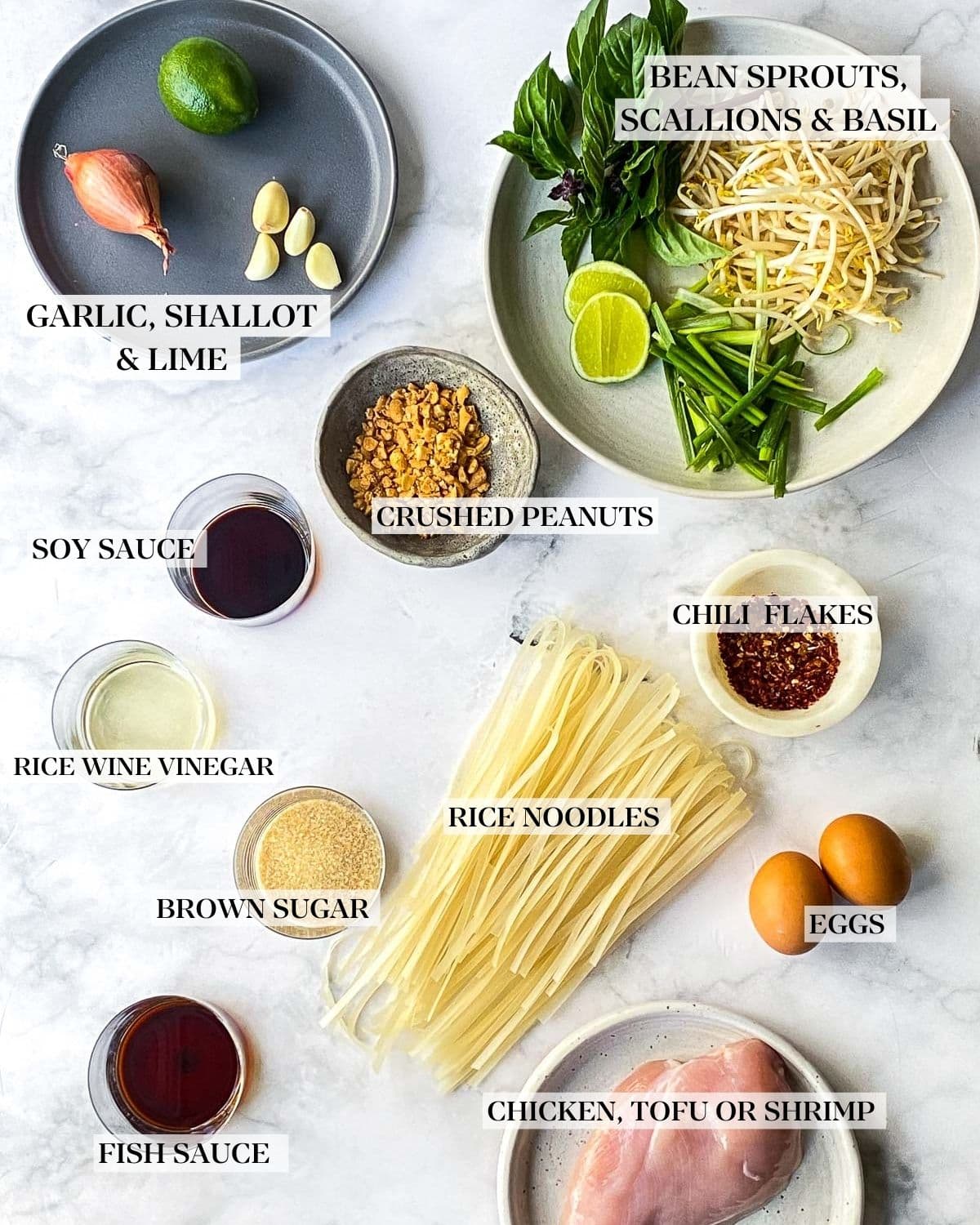
Pad Thai Ingredients
- Rice Noodles: Pad Thai is typically made with noodles called “rice stick”, which are rice noodles that are about 1/4 inch wide. Some brands are better than others- many fall apart when stir-frying. I have had the best luck with Thai Kitchen rice noodles. Make sure to soak the noodles, rather than boil, to prevent breaking.
- Protein: Add thinly sliced chicken breast, shrimp, or crispy Tofu, or leave out the protein and add stir-fried veggies. Extra firm tofu works best.
- Eggs: Traditional pad thai has scrambled eggs, vegans can leave this out.
- Garlic cloves and shallots: Shallots really elevate Pad Thai. I highly recommend shallots over onions if possible. Some versions use ginger, but in Thailand, they generally don’t.
- Fresh Lime Juice: adds acidity.
- Garnishes: The garnishes make Pad Thai, adding texture and flavor. Sliced green onions, crushed roasted peanuts, fresh bean sprouts, Thai chili flakes and lime wedges and if available, Thai basil, all elevate!
Pad Thai Sauce Ingredients
The secret to the best Pad Thai Sauce is the perfect balance of salty, sweet and sour. Our sauce has delicious umami and depth, while not being overly sweet with a lovely tang. Letting the sauce caramelize in the wok for just a few seconds, adds a lovely smokiness.
- Fish Sauce – Fish Sauce can vary in degrees of saltiness from brand to brand. I like Red Boat Fish sauce, or Thai Kitchen Fish Sauce (found at most grocery stores) best for this recipe. (*Vegans can sub our vegan fish sauce and soy sauce.) If you are new to fish sauce, keep in mind, it has a little “funk” to it. You can start off lighter and replace the rest with soy sauce.
- Tamarind Water or Rice Wine Vinegar – authentic Pad Thai is made with tamarind water and lime juice to give it the sour component, but feel free to use Rice Wine Vinegar and lime to keep things simple here. See recipe notes for using tamarind.
- Sugar – In Thailand, it is traditional to use palm sugar but we use brown sugar, coconut sugar or regular cane sugar to add sweetness. Note: Do not be tempted to cut back on the sugar, the Pad Thai will be too sour.
- Soy Sauce – adding a little soy sauce adds even more depth. You can also use gluten-free liquid aminos!
How to make Pad Thai (easy Instructions)
Step 1: Soak the rice noodles. Pour boiling water over the rice noodles let them soak until they are soft and pliable (about 5-6 minutes) but not overly soft; drain.
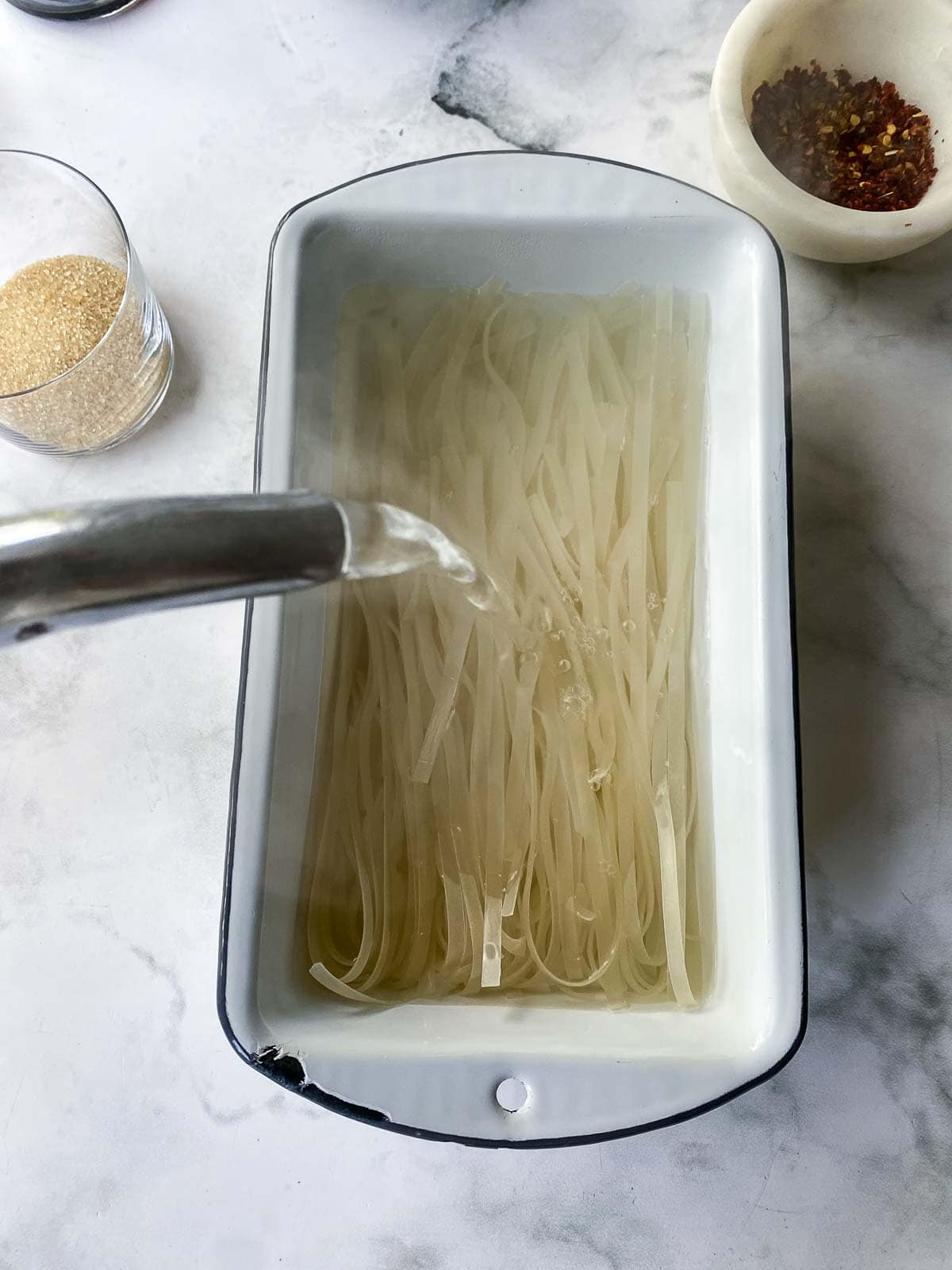
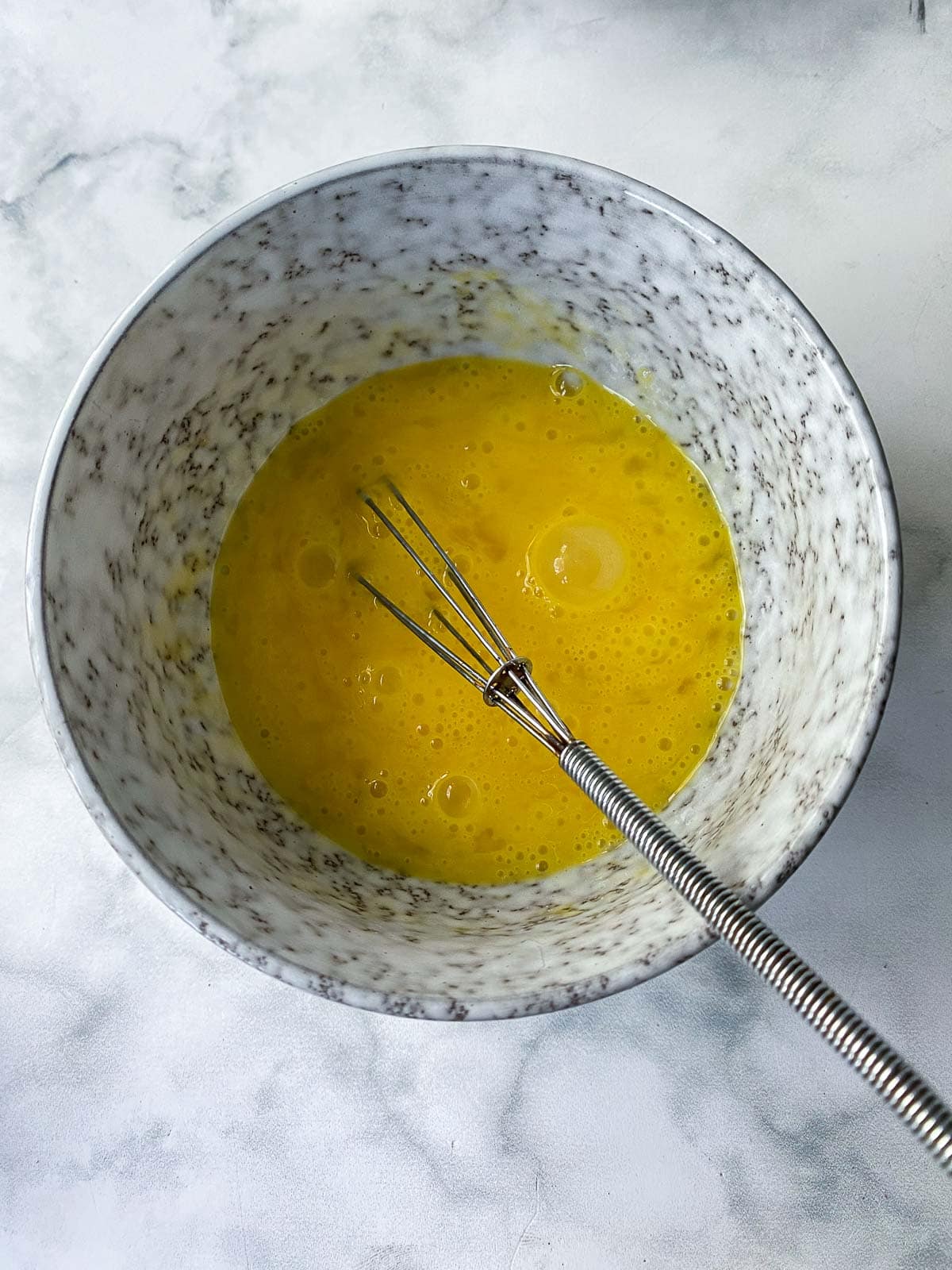
Step 2: Whisk the Eggs. Whisk the eggs in a medium bowl with a pinch of salt. Set aside by the stove.
Step 3: How to make Pad Thai Sauce. Whisk the pad thai sauce ingredients together in a small bowl- keeping in mind, there is a delicate balance between salty, sour and sweet, so if you alter one ingredient, you may need to adjust the others. Make sure the sugar completely dissolves.
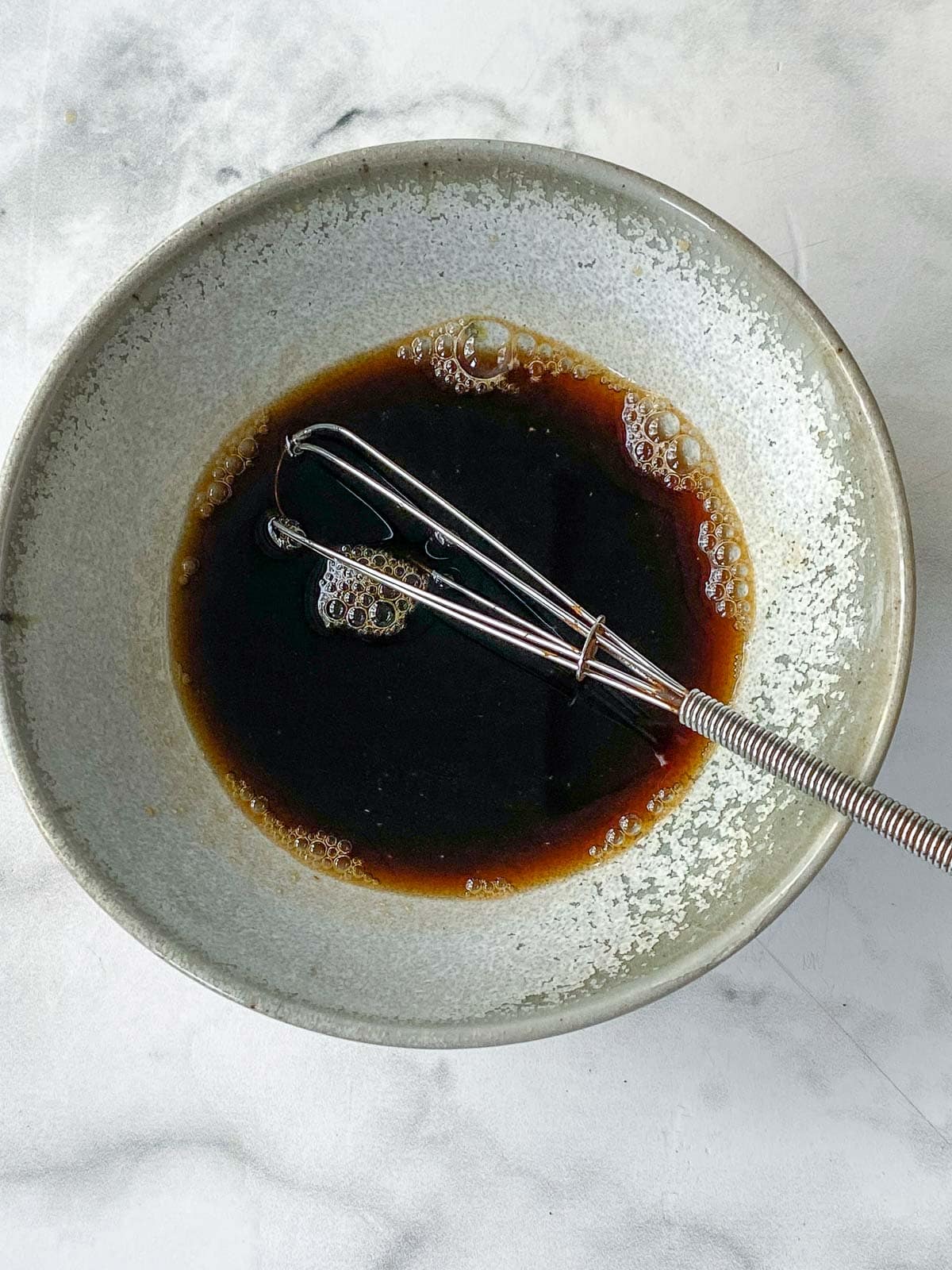
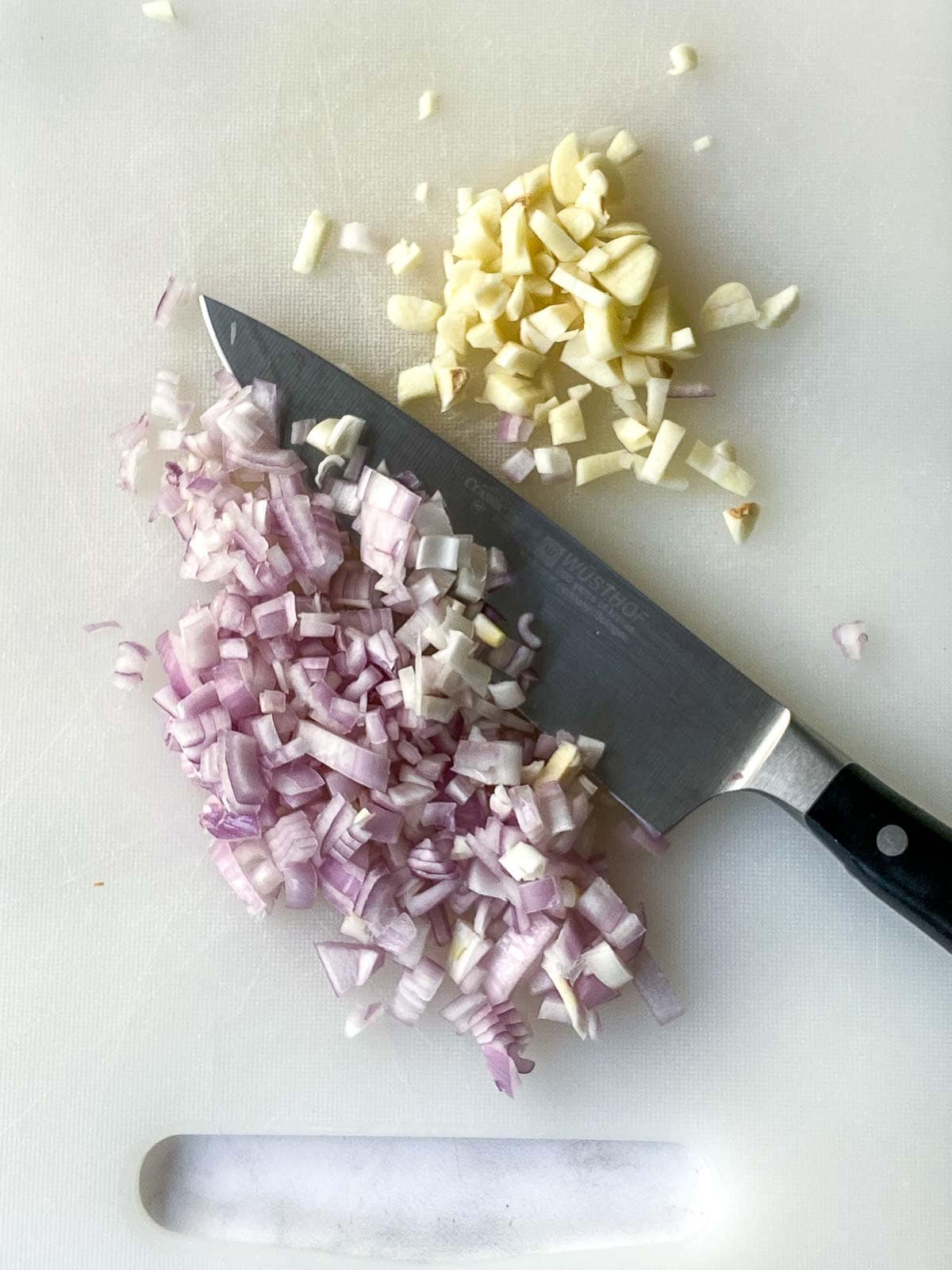
Step 4: Prep the Protein & Veggies. Chop the shallot and garlic finely and set aside. Slice chicken thinly across the grain (or peel and devein shrimp). If adding veggies, chop or slice them small, so they cook quickly in the wok.
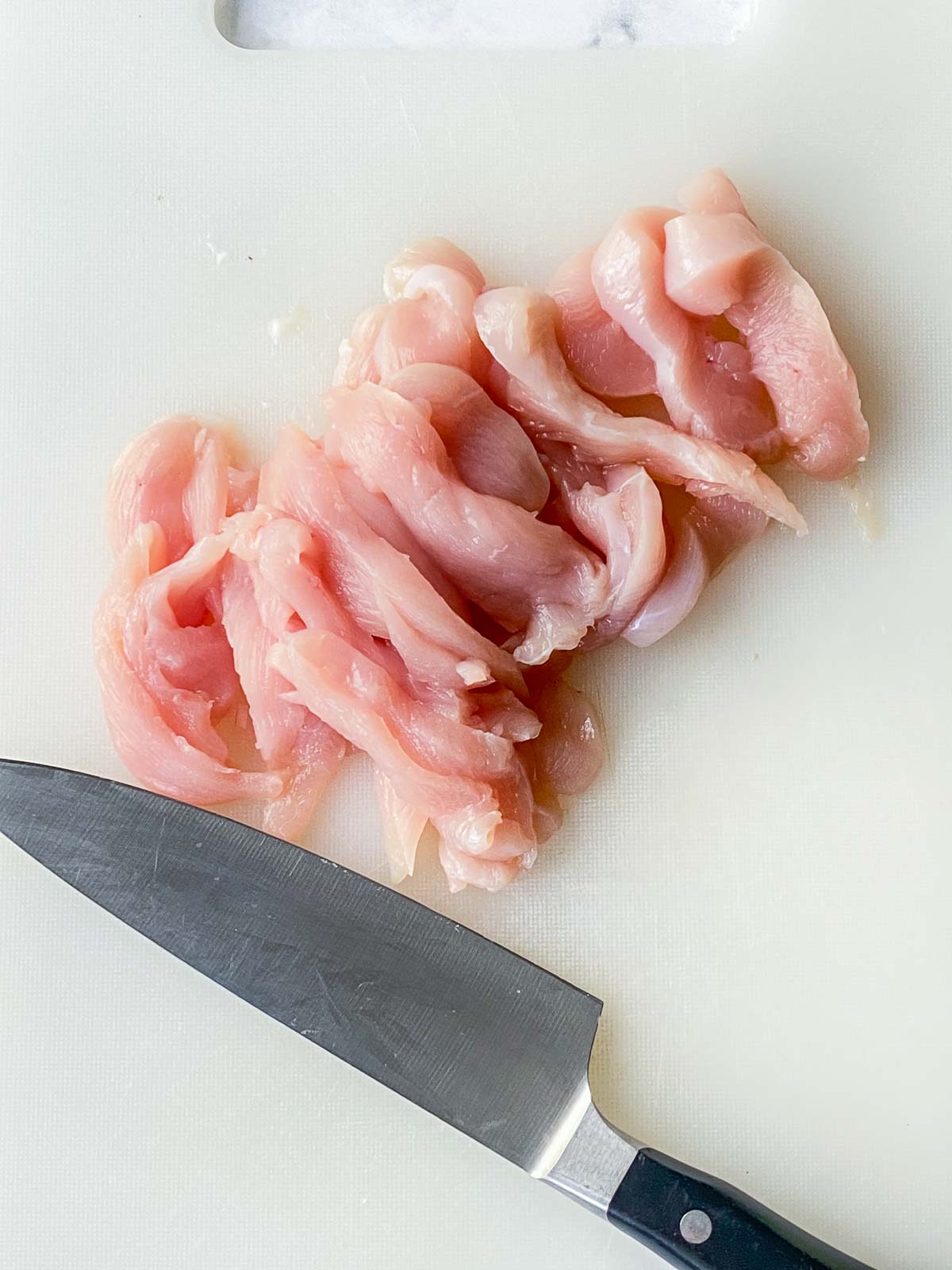
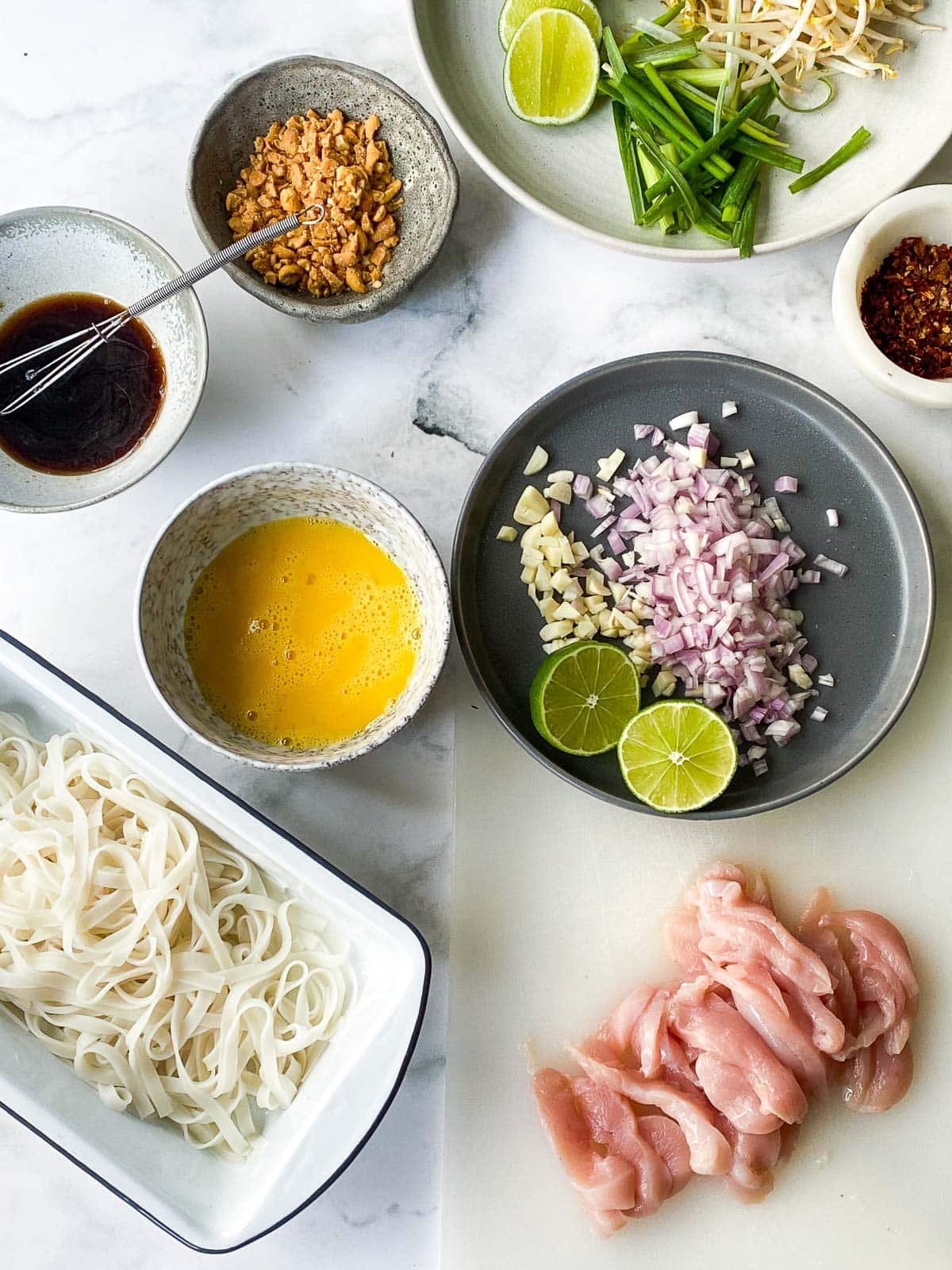
Step 5: Prep all your garnishes and have everything ready to go by the stove, keeping in mind the stir fry part will go quickly!
Step 6: Stir Fry! Season the protein with salt and pepper, and stir fry in a carbon steel wok until just cooked through and set it aside. If adding veggies, stir-fry these now and set aside as well.
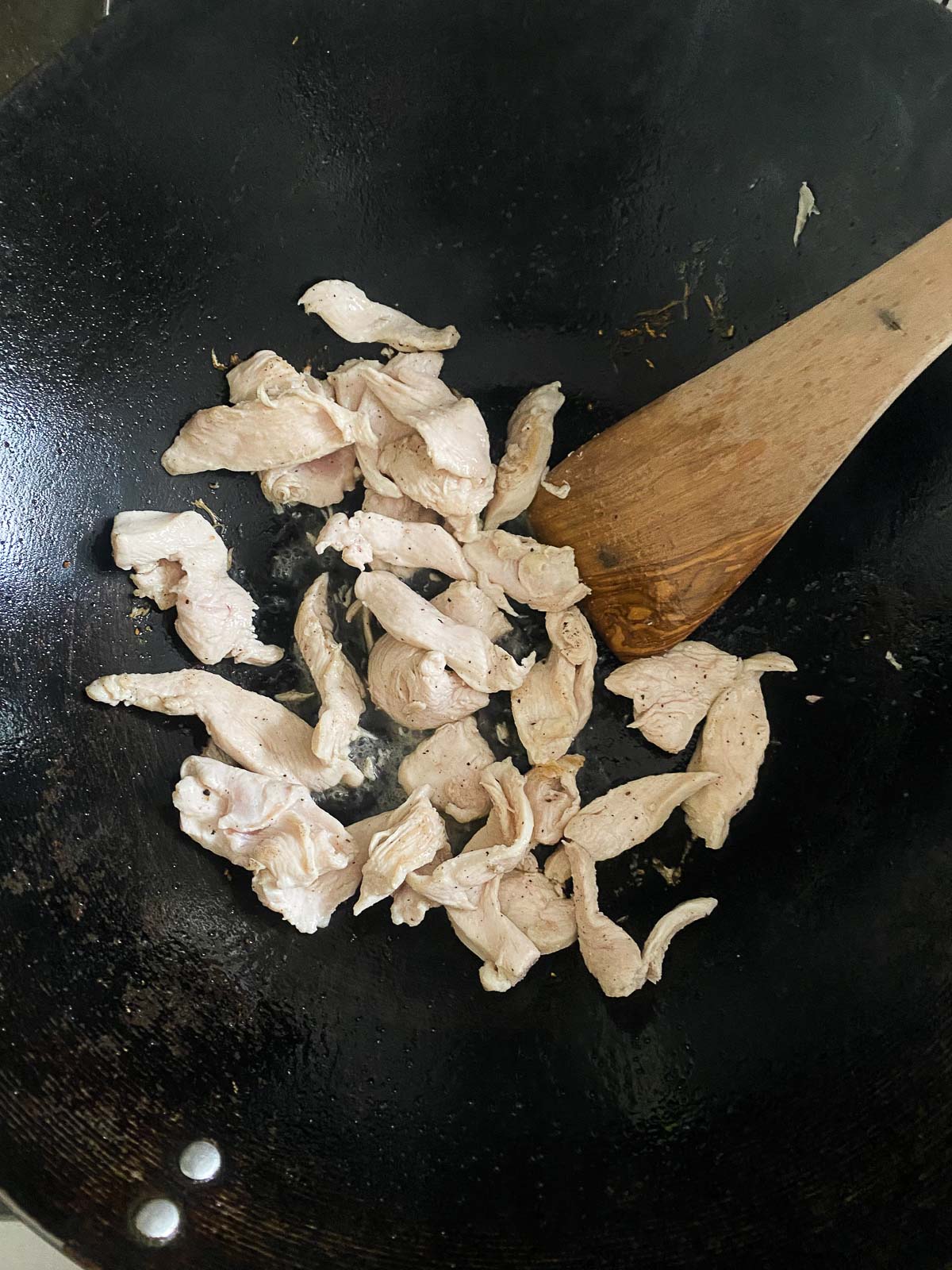
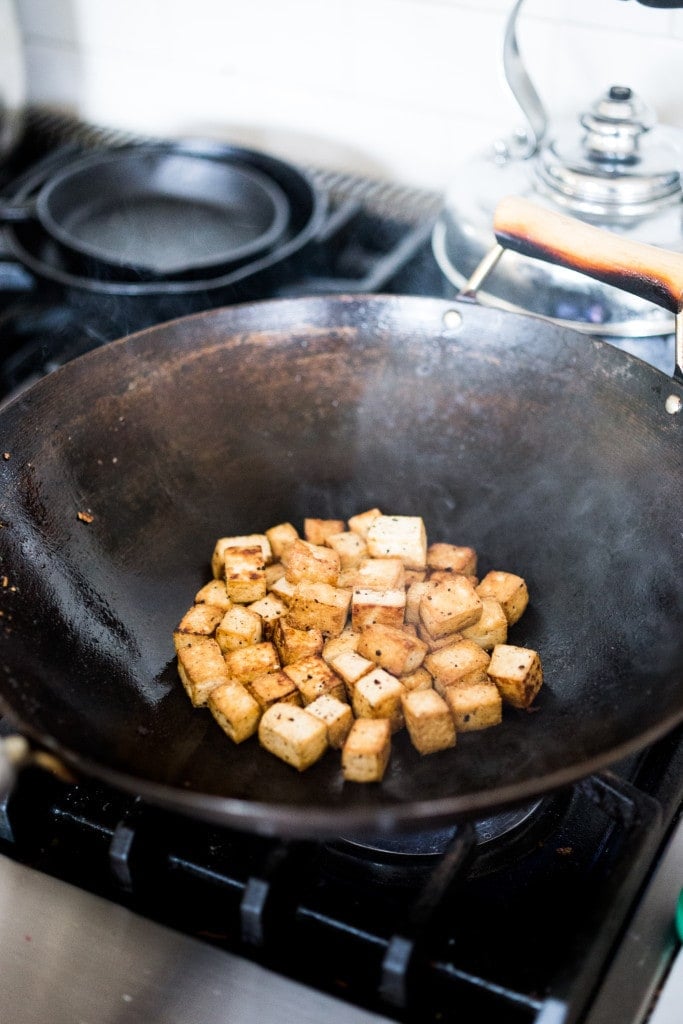
Add more oil to the wok and stir fry the garlic and shallots for just a couple minutes, scoot them over, add more oil if needed, and add the whisked the eggs, scrambling and breaking to bits.
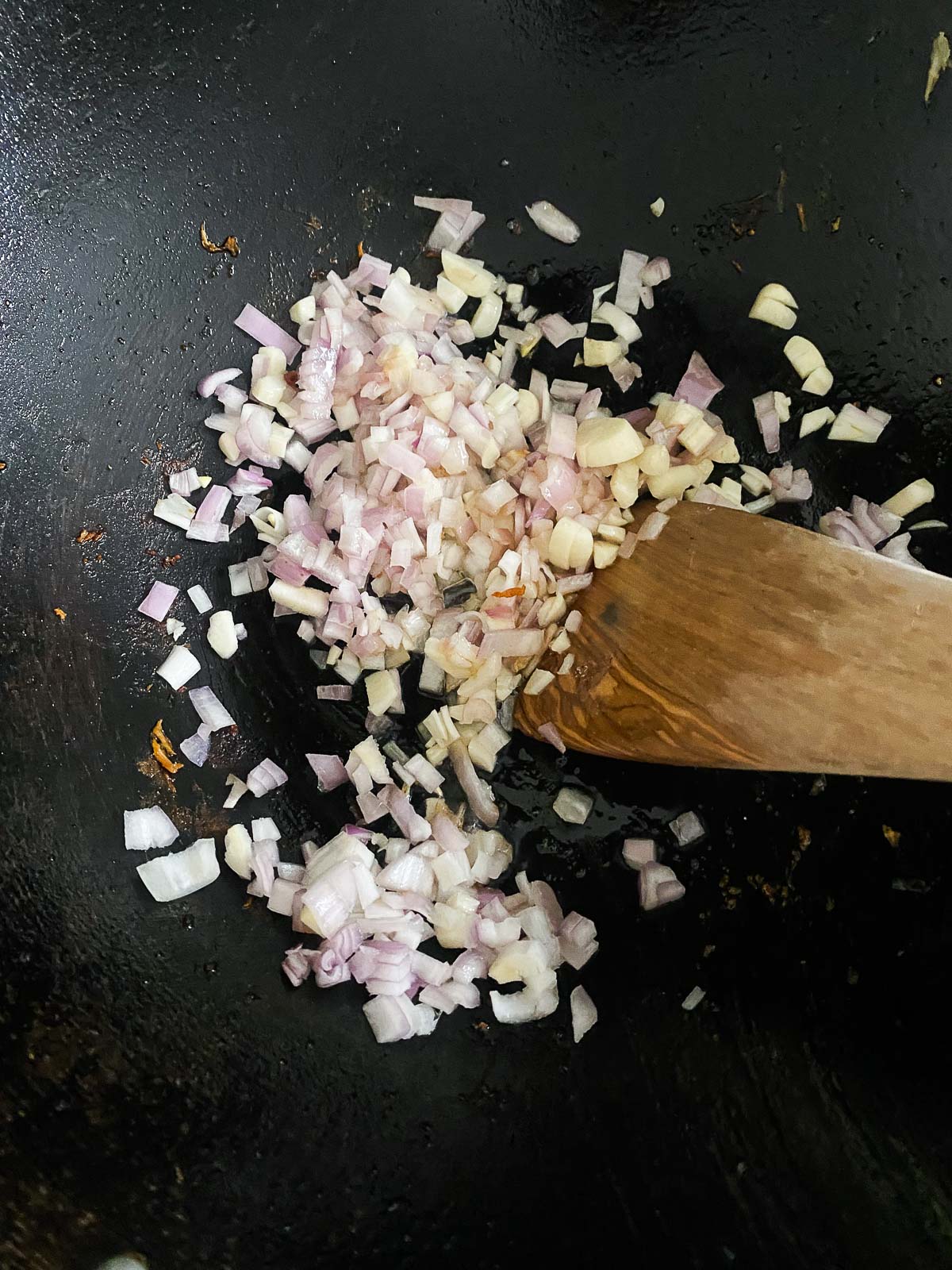
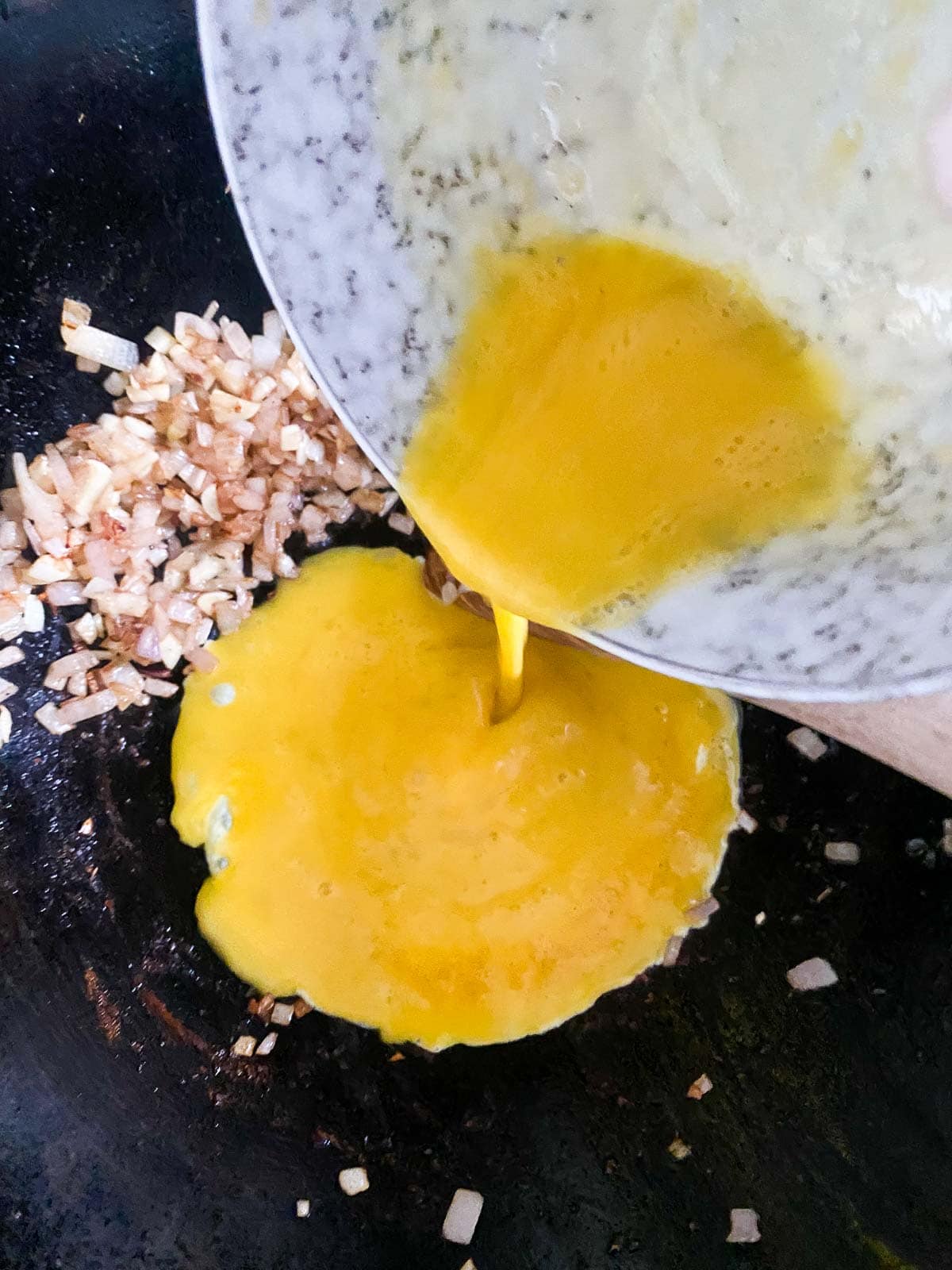
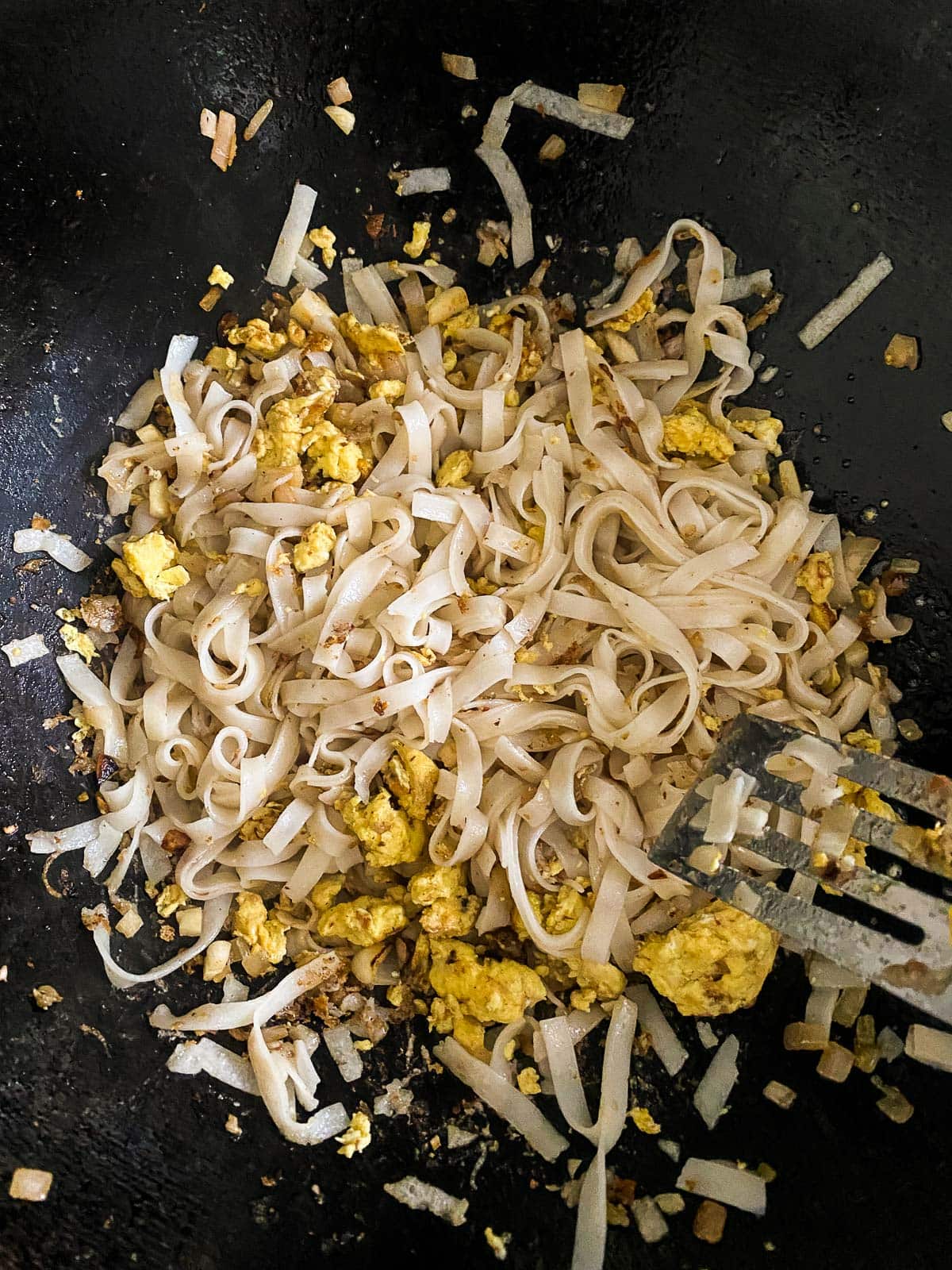
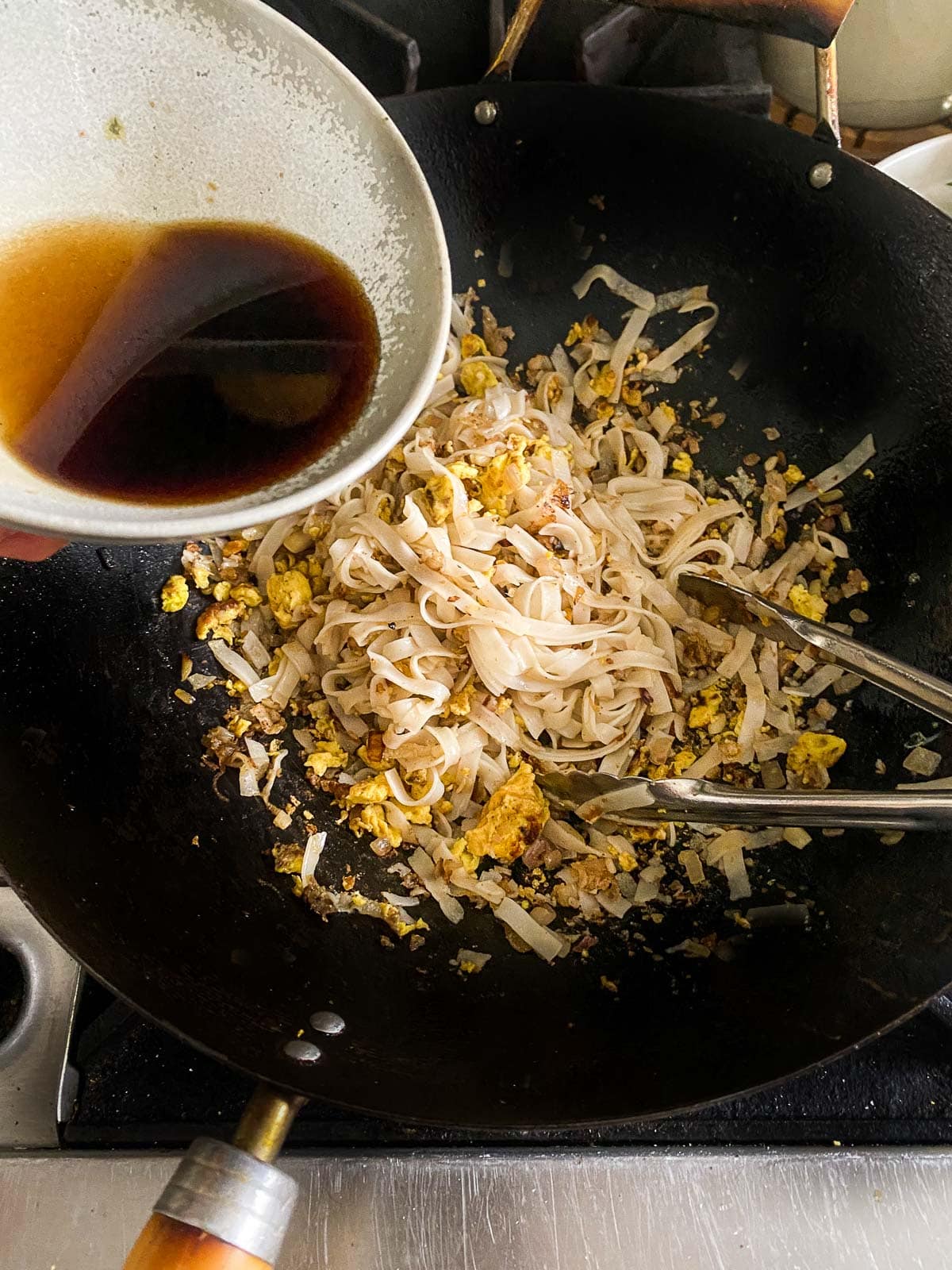
Scoot the eggs over and add more oil and stir fry the noodles, letting the noodles get a little crispy! Turn your hood on and pour in the Pad Thai Sauce. Let the sauce caramelize for 30 seconds, until you smell the sugar caramelizing. This will add great flavor!
Add back in the cooked protein and veggies, with some of the bean sprouts and scallions. Add a squeeze of lime.
*Taste and adjust salt, lime or sugar to taste. Find the perfect balance. See FAQ’s for troubleshooting the flavors.
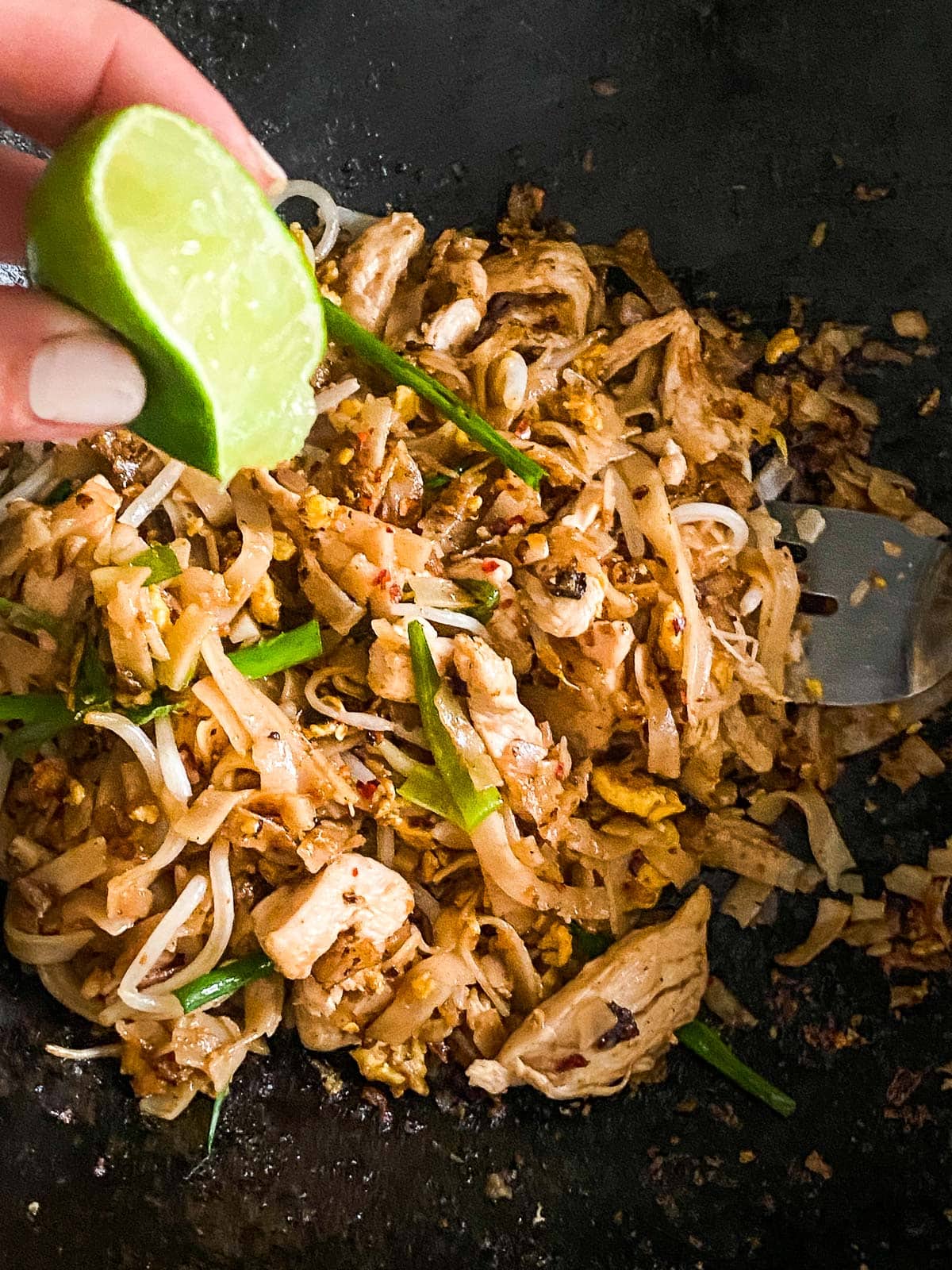
Step 7: Serve. Divide between 2-3 bowls and garnish with fresh bean sprouts, lime, wedge, crushed peanuts, chili flakes, scallions and basil. For extra heat, serve it with our chili garlic sauce!
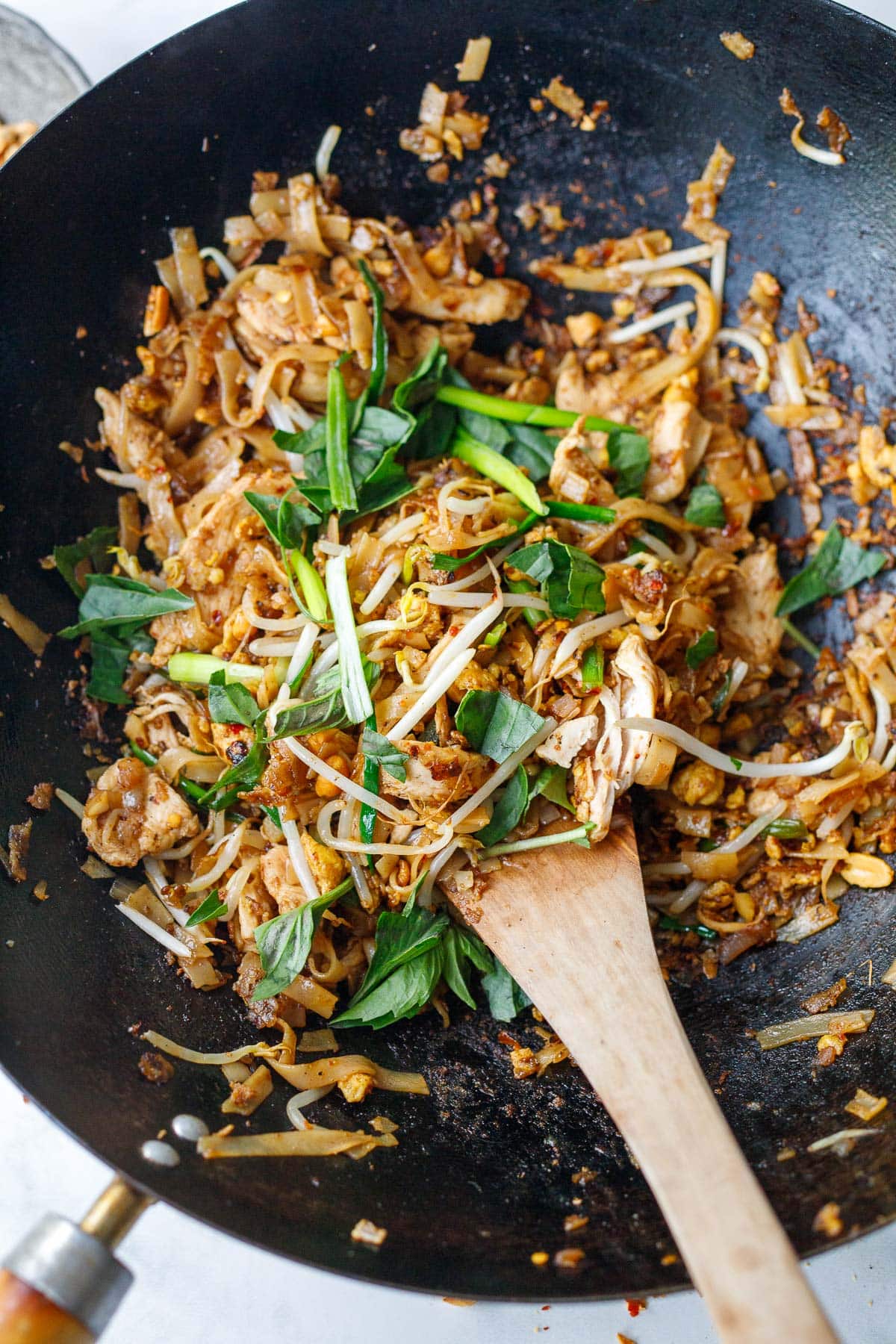
Pad Thai Noodle Tips
- Read the whole recipe through before you give it a go.
- Prep everything first, then place it near the stove. Cooking goes very fast here!
- Cut chicken very thinly to cut down on cooking time. Remember to cut across the grain, into ⅛ -¼ thin strips about two inches long.
- To lower calories, poach the chicken in a little salted water, until cooked through which just takes a couple of minutes. Then set it aside.
- Use shallot. Shallot adds so much flavor here- much more so than onion.
- Crispy noodles. Crisp up the rice noodles in the pan before adding the sauce.
- Let the Pad Thai sauce caramelize in the wok, before turning off the heat. This is the secret to the best flavor- a smoky sweetness we all crave!
Pad Thai Don’ts
- Please do not add ketchup or peanut butter. This is not authentic and takes away from the dish.
- Don’t use white vinegar instead of rice vinegar. White vinegar tastes way more acidic and it will be overly sour.
- Don’t skip the sweetener. you will lose the balance of the dish. You will end up with fishy, overly sour, salty Pad Thai that tastes terrible. TRUST ME.
- Don’t make too big of a batch. The noodles are stir-fried. You want the noodles to get slightly crispy in the pan, and the sugars to caramelize, giving them that incredible smoky flavor- this is difficult to achieve if making huge batches.
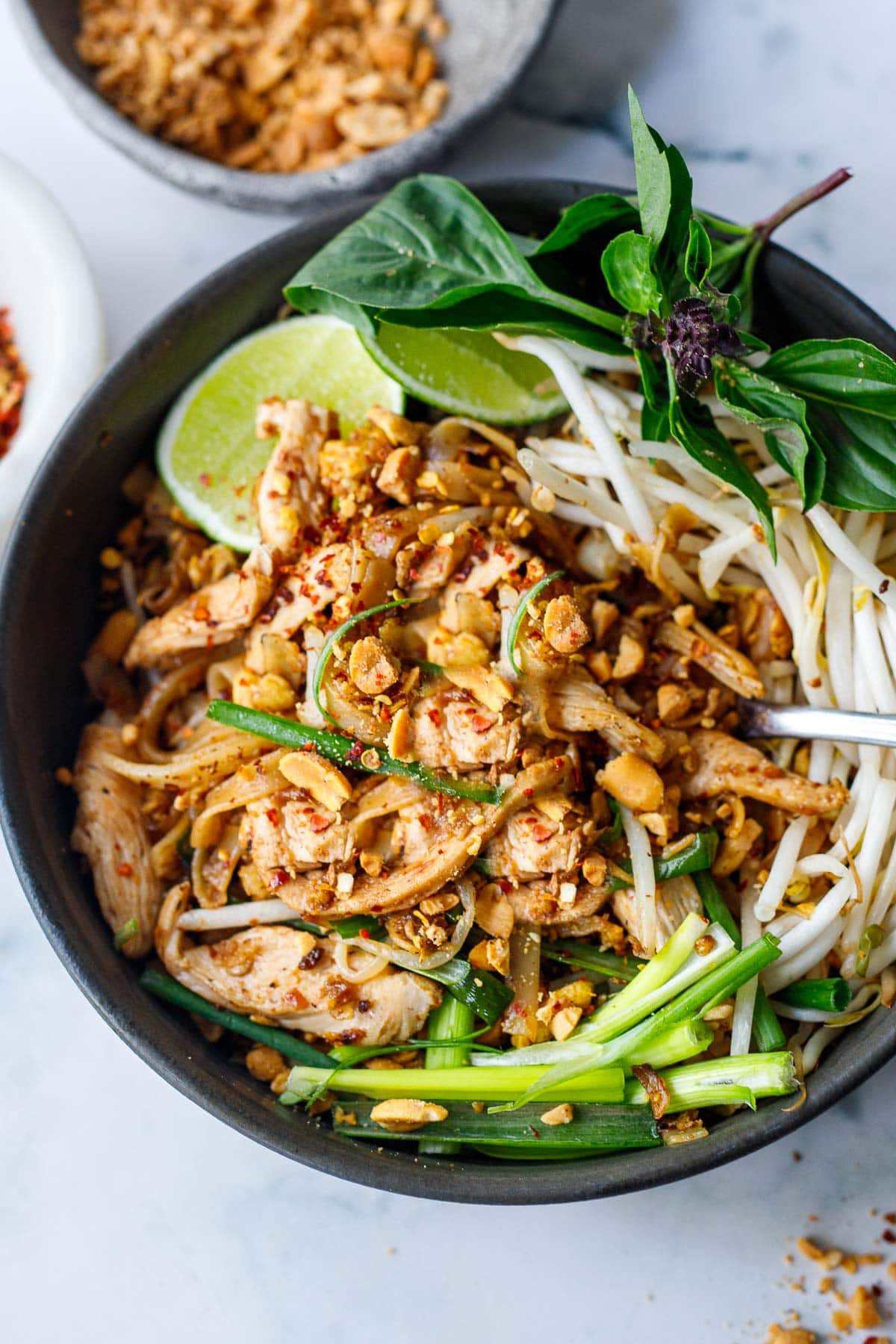
Serving Pad Thai Noodles
- Serve Pad Thai with lime wedges.
- Add fresh bean sprouts.
- Sprinkle with crushed roasted peanuts (or try this amazing Peanut Chili Crunch!)
- Add chopped scallions or Thai basil.
- Serve with Thai chili flakes, sriracha or chili paste for extra heat.
Storing Homemade Pad Thai
Pad Thai is best served right after it is cooked. Leftovers will last up to four days in an airtight container in the refrigerator. Reheat pad Thai in a skillet or wok, lightly stir frying.
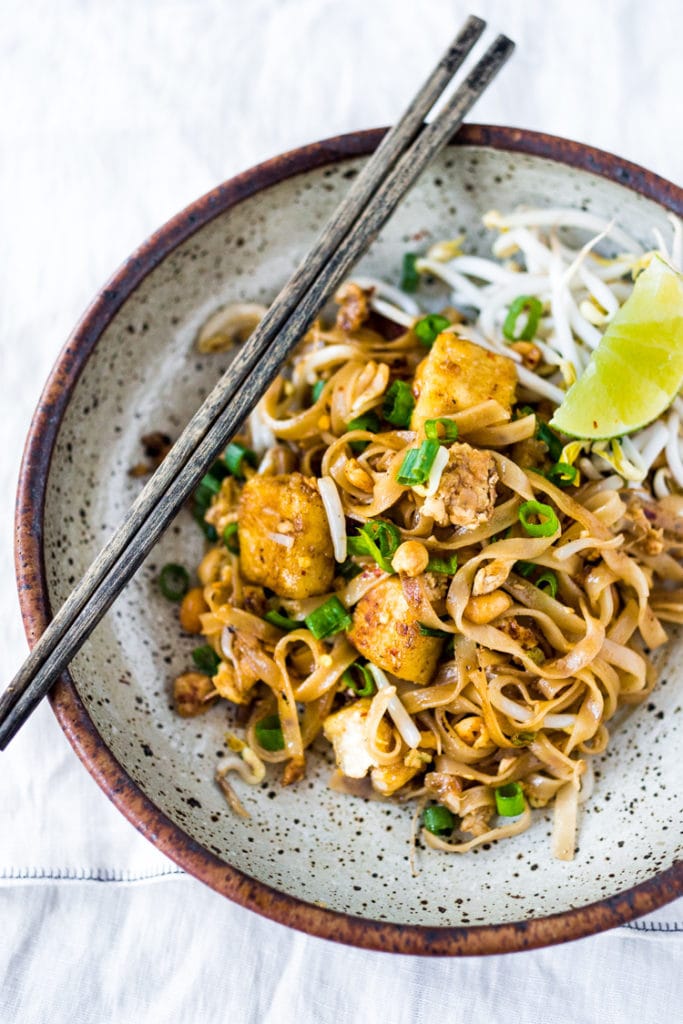
Pad Thai Recipe FAQs
Yes, Pad Thai can easily be made vegan. Use vegan fish sauce or soy sauce and crispy tofu as the protein, and leave out the eggs.
The secret to the best Pad Thai is not overcooking the rice noodles, using a very hot wok, cooking in smaller batches so rice noodles can caramelize, and having the perfect balance of flavors- not too sweet, not too sour, and not too salty.
Peanut oil adds the best flavor, while avocado and coconut oil both have a high smoke point. Both work well here. Any neutral high heat oil will work.
Any quick-cooking vegetables that can be cooked in a wok can be added to Pad Thai- asparagus, green beans, matchstick carrots, bell pepper and bok choy to name a few. Feel free to add steamed broccoli too!
Try adding a little more brown sugar and vinegar to balance it.
Add a little more brown sugar to balance it. White vinegar will do this- so always use rice wine vinegar, tamarind water or lime, which are all less acidic.
Add more acid ( rice vinegar, tamarind water or lime juice) to balance it.
What to serve with Pad Thai!
I hope that after you make this, you’ll think this is the best Pad Thai recipe you’ve ever had too! 😉 Haha! Let me know in the comments below! 🙂 Here are more of my favorite Fast, Easy Dinner Ideas!
Happy weekend.
xoxoxo
PS. It is my hope that through cooking, we not only learn new ingredients and techniques but also learn more about the culture and people from which the food we make originates. Cooking can be a way of celebrating all our unique and beautiful differences. I’d like to believe expanding our repertoire in the kitchen can also expand our hearts.
More Favorite Thai Noodle Dishes!
Love Thai Cuisine? Try…
- 33+ Easy Thai Recipes!
- Authentic Tom Kha Gai (Thai Coconut Chicken Soup)
- 30-Minute Thai Green Curry
- Thai Larb Salad
You may also love this Malaysian Char Kway Teow or Chickpea Curry!
More from Feasting At Home
How to make Pad Thai Noodles | Video
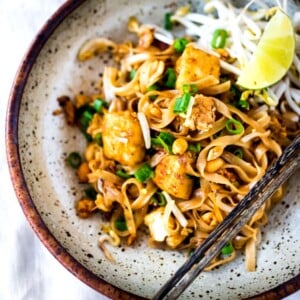
Easy Pad Thai (Chicken, Tofu or Shrimp)
- Prep Time: 15 mins
- Cook Time: 15 mins
- Total Time: 30 minutes
- Yield: 2
- Category: Main
- Method: stir-fried
- Cuisine: Thai
- Diet: Vegetarian
Description
An easy, 30-minute recipe for Pad Thai made with rice noodles, your choice of chicken, shrimp or tofu, scrambled eggs, and an incredible “not too sweet” Pad Thai Sauce. Makes 2 large servings. Watch the video!
Ingredients
- 4 ounces rice noodles
- 3 tablespoons peanut oil, divided ( or use avocado oil, or coconut oil)
- 8 ounces chicken breast, tofu or prawns (peeled and deveined)
- salt and pepper to taste
- 1 large shallot, finely diced (much better than onion here)
- 4 fat garlic cloves, roughly chopped
- 2 eggs, whisked with a fork with a generous 3-finger pinch salt if vegan, leave it out)
- 1 lime
- 1 1/2 cups bean sprouts
Pad Thai Sauce:
- 3 tablespoons fish sauce (see notes- or use vegan fish sauce)
- 3 tablespoons brown sugar (or coconut sugar, palm sugar, or regular sugar) see notes
- 3 tablespoons of rice wine vinegar (or tamarind water– see notes) do not sub white vinegar, it will be too sour.
- 2 teaspoons soy sauce (or GF liquid aminos like Braggs)
Garnish:
- lime wedges, fresh bean sprouts, chili flakes, chopped scallions, roasted peanuts, Thai basil
Instructions
- Soak the rice noodles. Place rice noodles in a shallow pan and cover with boiling water for 4-7 minutes, stirring occasionally (so they don’t stick together) until al dente; drain, rinse with cold water to stop cooking. They don’t have to be totally soft, just bendy and pliable.
- Whisk the two eggs in a bowl with a fork and add a generous, 3-finger pinch of salt. Set aside.
- Make the Pad Thai Sauce: whisk fish sauce, rice vinegar, brown sugar and soy sauce. (see notes) in a small bowl. Set aside.
- Prep the protein. Chicken: slice chicken into very thin strips and season with salt and pepper. Crispy Tofu: Blot tofu with paper towels pressing down firmly. Cut tofu into ¾ inch cubes, sprinkle with salt and pepper, and for extra crispy, dredge in a little corn starch. Shrimp: season with salt and pepper.
- Cook the protein: Heat 1 tablespoon oil in a large saucepan or wok, over medium-high heat. Sear the seasoned chicken, shrimp or tofu until cooked through. Set aside,
- Stir Fry: Gather your chopped shallots and garlic, whisked eggs, cooked noodles, cooked protein and Pad Thai Sauce around the stove. Heat a little more oil in the wok over medium heat, add shallot & garlic and stir fry 2-3 minutes. Scoot the shallot mixture to the side, add more oil, and pour in the eggs. Scramble and break them apart into little bits, and move them to the side. Add more oil, and the noodles, stirfry 2-3 minutes until noodles are soft and pliable and even a little crispy.
- Pour in the Pad Thai Sauce (turn hood on) stir everything together and cook 1-2 minute, then add the cooked protein and stirfry for a few more minutes. Just as you start to smell the sugar carmelizing, you are there! Squeeze with a little lime juice. Turn off heat.
- Taste. Adjust salt, lime, heat and sweetness to your liking; add salt, or soy sauce for more depth if you like, a squeeze of lime juice, chili flakes, or a pinch of sugar to taste.
- Toss in 1/2 the bean sprouts and roasted peanuts (or serve on the side) and sprinkle with chili flakes and scallions. Give one more toss and serve immediately. Divide among two plates.
- Garnish with more bean sprouts, fresh scallions, cilantro or basil, chili flakes, lime wedges and roasted crushed peanuts. Or make this Peanut Chili Crunch!
Equipment
Notes
Fish Sauce: If you are not accustomed to fish sauce, or are using a brand you haven’t tried before (some are fishier than others) feel free to go lighter on the fish sauce– like 2 tablespoons. If going with less, replace it with soy sauce.
Poach the chicken. An easy way to cut back on the oil in the recipe is to poach the thinly sliced chicken breast in a little salted water, or broth for a few minutes, until cooked through. Drain and set aside. The thinner you slice the chicken the faster it will cook.
Tamarind: If using tamarind paste (instead of rice vinegar) make tamarind “water” by mixing 1 tablespoon tamarind paste with 2 1/2 tablespoons hot water. If using tamarind “concentrate” mix 1-2 teaspoons with 2 1/2 tablespoons water. Use tamarind water in place of the vinegar. Using tamarind is more authentic but not everyone has access to it. Tamarind is extremely sour so if unfamiliar, go light. You can always add more lime to taste.
Nutrition
- Serving Size: 1 ½ cups
- Calories: 409
- Sugar: 14.3 g
- Sodium: 1134 mg
- Fat: 14.2 g
- Saturated Fat: 2.1 g
- Carbohydrates: 47.4 g
- Fiber: 1.1 g
- Protein: 20.5 g
- Cholesterol: 165.4 mg
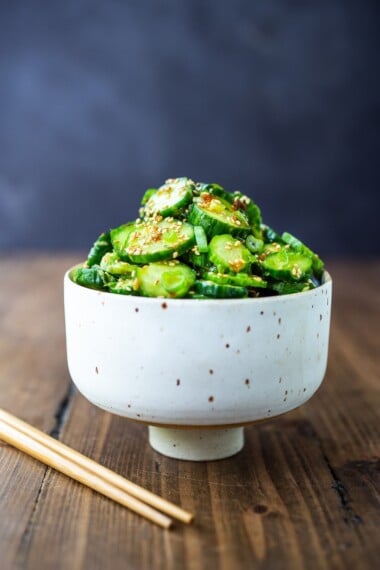
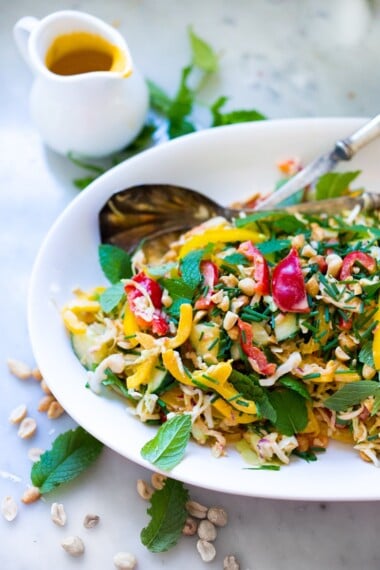
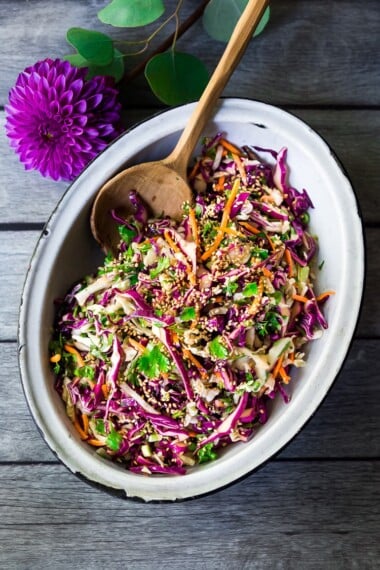
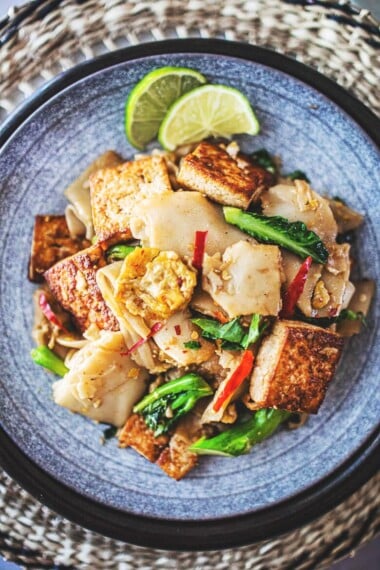
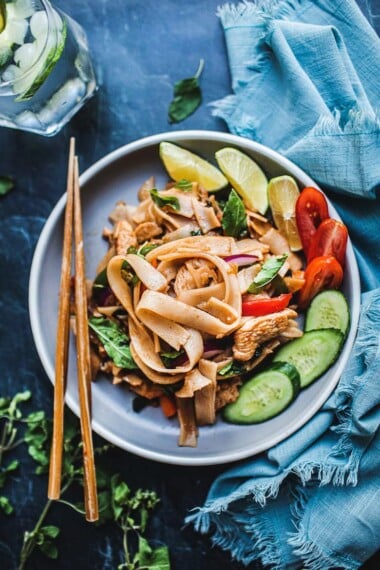
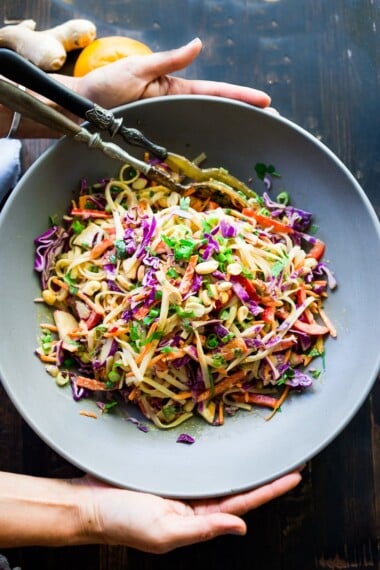
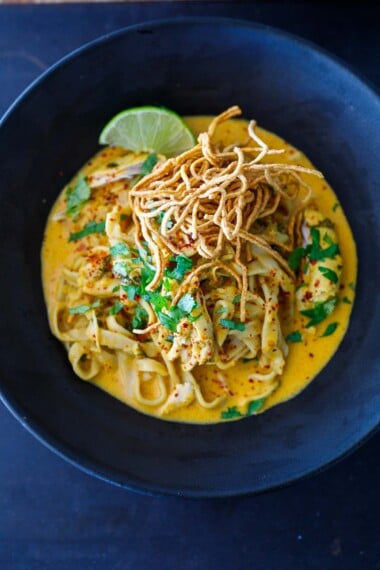
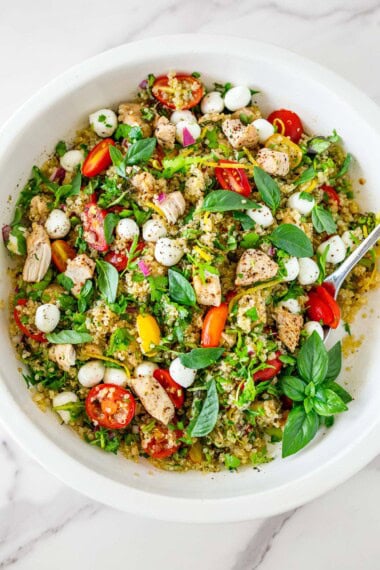
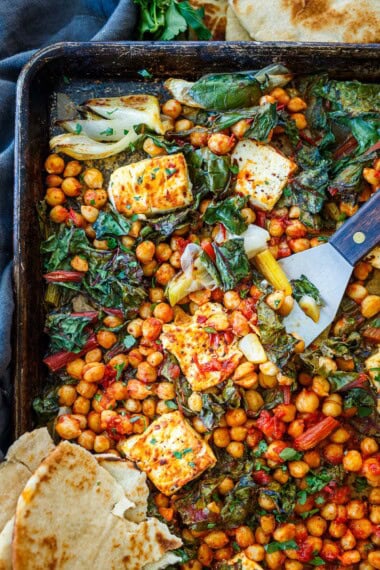
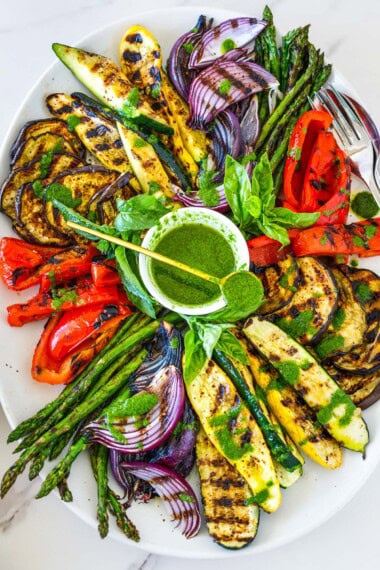



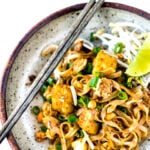
Amazing recipe ! Just as good as our local Thai restaurant ,I used tamarind instead of rice vinegar as suggested in the notes.
So happy you liked it and tried it with the tamarind!
Hi
I wanted to use Tamarind instead of the Rice Wine Vinegar but I wasn’t sure how much to sub it for? How much would you recommend putting in?
Great question! Mix 1 tablespoon tamarind paste with 2 tablespoons water and use instead of vinegar.
Loved this recipe, very easy and quick with ingredients I had at home. My family loved it – I have a printed copy and it will become a staple. The peanut /chili crunch makes it really special. I would not skip it.
Awesome glad you liked it!
Made this the other night and was great!
Was missing some of the ingredients (the funniest of which was peanuts, which I ended up pulling out of several individual bags of trail mix … first time I’ve ever left the m&ms untouched). So I ended up subbing a green onion for the shallot, and I ended up cooking the chicken in sesame oil which was a GREAT addition!
The other thing was subbing worcestershire sauce in for the fish sauce, which I think helped reduce the “fishyness” of the dish considerably without having to sacrifice taste.
Anyway, thought you’d appreciate the possibilities of my un-planned subs.
Love your resourcefulness! Way to think outside of the box- love it!!!
The most amazing recipe ever! Thank you for sharing.
So simple, yet so much flavor! Thanks for another great recipe.
Pad Thai without Tamarind……is this a joke or just incompetence? Zero Stars
If you read her post, you’ll see she created the recipe for people who don’t have time to go the Asian market and get tamarind. And it is obvious, you haven’t tried it. I make this all the time and it’s great. She has another very authentic Pad Thai recipe on the blog with tamarind and dried shrimp.
Why so harsh with your comment?! Not everyone has access to Asian stores with ingredients for a traditional Pad Thai recipe. Clearly Sylvia’s aim is to help her readers make a tasty recipe with easier to find ingredients. And-it looks like she helped plenty of happy people with this yummy recipe.
Check the notes- there is a tamarind option below.
thank you for the tip on cutting the chicken thin and lightly steaming. Came out light and flavorful. Will make this again.
Yep. It’s the best. I normally use tamarind water, but left it out to save a trip to the store. Still came out perfect.
I’ve made this with tofu and another times with chicken, comes out delicious every time. On regular rotation.
Easy and amazing. I’ve made this several times and never thought to rate. Such a keeper. The whole family enjoys.
I’m not sure what went wrong but my tofu was horribly mushy and the noodles completely stuck together in one unmanageable lump after soaking. Such a bummer this one didn’t work out as it seemed like a great recipe!
Good recipe except the noodles definitely need to go in last. Even if you don’t cook them all the way it still ends up mushy and the chicken doesn’t cook evenly at all.
Everyone loved this! Easy and tasty!
Delicious Pad Thai. Used turbinado sugar and tamarind concentrate. Used carrot matchsticks, brocolli thinly sliced, mushrooms, celery, and chicken. Had no bean sprouts. But this made a very tasty dinner! The sauce was perfect. Topped w cilantro, green onion slivers, crushed peanuts, and a squeeze of fresh lime. Yummy and light dinner!
Loved this simple recipe for Pad Thai. I’ve made it in the past with tamarind, but ran out and didn’t want to go to the store, so tried your simplified recipe. It was delicious!
Awesome recipe! So easy and flavorful! if i could give it 10 stars I would!
This is the BEST! thanks for sharing, family loves it too.
Made this easy Pad Thai recipe for my family and it was one of the best meals I’ve ever made! Thanks for sharing your delicious recipes
This really IS the Best Pad Thai recipe I’ve ever had! My husband constantly asks for it, it’s a total winner in our house. The Pad Thai Sauce is perfectly balanced. On regular rotation!
Fantastic! We couldn’t stop eating it.
Yum. A winner!
Yum! So good! (my husband said, “best pad thai in town”, and my picky daughter had seconds!) It took me much longer than 15 minutes but I doubled it (and I’m slow) I’m sure it will be faster next time.
However, I did not double the fish sauce, sugar, vinegar and soy sauce (I was afraid of too much fish sauce and sugar). Next time I will add more of both and go up to 4 T of fish sauce and sugar (and appropriate ratios for the vinegar and soy) I did have a block of tamarind in the back of the fridge and used that to make of some of the extra sauce, and held the lime to just wedges on the side. Thanks for another keeper, Sylvia!
Yay! So glad they enjoyed it!! Perfect to use tamarind!
I love this Recipe the only thing I change is, I use 3 tablespoon honey no sugar , and comes out Great !
Oh perfect, love it!
Very authentic! I loved it! I’d probably use less fish sauce next time but easy to make and easier to cook.